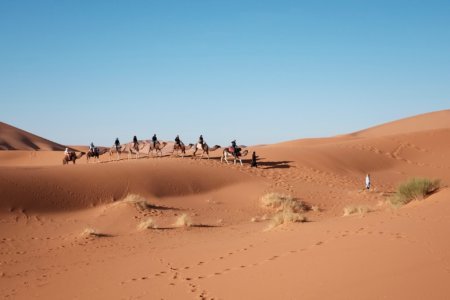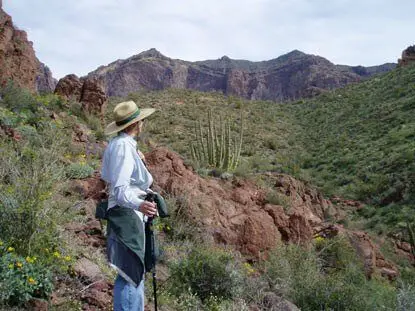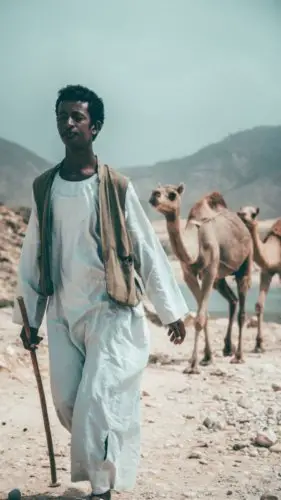Best Clothing for Desert Survival
Deserts are one of the most inhospitable climates on Earth! Depending on where you live, getting stuck in the desert can be a very real risk.
What is the best clothing for desert survival? Desert survival clothing should be lightweight and cover your body. Use this list to pack the best clothing for desert survival:
- Wide-brimmed Hat
- Long-Sleeved Shirt
- Long Pants
- Long Underwear
- Light Jacket
- Light Raincoat
- Socks
- Bandana or Shemagh
- Quality Hiking Boots
Ideally, you would wear lightweight clothing during the day and heavier clothing to keep you warm during the night.
[wc_toggle title=“Table of Contents” padding=“” border_width=“” class=“” layout=“box”]
[/wc_toggle]

What are the Best Clothes to Wear in the Desert?
The clothing listed below will keep you alive much longer than if you just strip down trying to cool off. It may be tempting in the summertime to ditch the clothing because it initially feels better, but it’s not the right survival choice.
Wide-brimmed Hat - A wide-brimmed hat is one of the most essential desert survival clothing items. Keeping the sun off your head, face, and neck will keep you much cooler and comfortable in the long run. It also helps to protect your eyes from the glaring sun.
Long-Sleeved Shirt - Wearing a long-sleeved shirt will keep the sun off of your arms and prevent them from getting sunburned. It also protects against wind.
Choose a shirt that is made of light materials (light cotton is what I tend to choose) and loose-fitting. I like to make sure that it has a collar that I can flip up if I need to in case I don’t have a shemagh or a hat to cover the back of my neck.
Long Pants - Long pants are great during pretty much any survival situation. They protect your legs from getting cut up by any bushes and shrubs on the ground and help keep bugs at bay.
Just like your shirt, your pants should be made of a light, breathable material so they protect from the sun and wind.
Cargo pants are usually a good option. Get them a little larger than you need so they remain breathable and allow airflow over the skin. Make sure you have a belt to keep your bigger pants in place.
Long Underwear - Most people don’t think about how cold your body can feel in the desert. Most of the time there isn’t any kind of foliage to help trap the heat of the day in the ground. This means that as the sun drops down the ground is going to cool off pretty quickly, leaving you feeling cold and miserable.
For nighttime survival in the desert, you can pack long underwear made from a synthetic material like fleece. These types of materials a very warm while staying light enough to not be overly heavy when you don’t need it during the day.
Light Jacket - Having a light jacket to keep you warm is always a plus. Again, go for fleece or light synthetic materials so you don’t add a ton of weight to what you’re carrying around during the day.
A light jacket also makes you better prepared for potential swift changes in the weather, and weather can change really fast in the desert.
Light Raincoat - The idea of a raincoat in the desert can seem counter-intuitive, but it can be useful in some situations. It does rain in the desert (flash floods are a real concern in some places) so being prepared for it is important.
A raincoat can also add another layer to your nighttime clothing keeping you warmer and providing an extra layer between you and the ground.
Socks - When you look for socks, it’s always a good idea to look for moisture-wicking material to help keep your feet dry. Modern materials are better for this than traditional cotton materials.
When you’re dealing with fabrics being jammed into a boot that doesn’t really have a lot of circulation, modern materials can wick away moisture where other material will fail and just become a soggy mess.
Bandana or Shemagh - Bandanas and shemaghs are some of the best survival items you can have around. I prefer the shemagh over a bandana because it much larger which makes it a lot more useful for covering your head and face as well as any kind of improvided uses you can think of.
[wc_box color=“primary” text_align=“left” margin_top=“” margin_bottom=“” class=“”]
You can read all about the many uses of the shemagh here.
[/wc_box]
Hiking Boots - Look for boots that are lightweight and offer some breathability. There is almost nothing more important than a good pair of boots when you may need to walk for long periods of time to get you out of a survival situation.
If your feet don’t work because they’re blistered and beaten, your chance of surviving drops drastically!

Why is it Better to Stay fully clothed in a Hot Desert
Choosing your clothing for the desert is different than choosing how to dress for most other climates. It can actually be pretty counter-intuitive if you haven’t lived or worked in a desert environment before.
In the desert, you always want to cover as much of your skin as possible. This protects you from the harmful rays of the sun, protects you from blowing sand, keeps bugs away and protects you from the wind.
One of the most important reasons to cover up is that it limits the amount of water that your body loses by sweating. By trapping your sweat you can actually slow the rate that your body needs to sweat to keep your core body temperature down.
If you didn’t cover-up, the wind and sun would increase the rate that sweat evaporated from your body. To counter this, your body would have to produce more sweat and use up your body’s stored water much faster.
Best Color to Wear in the Desert
You’ll hear two opposite answers if you go looking for the best color clothing to wear in the desert. Some people are going to say wear white to reflect the heat and some will say wear black to help the body lose heat. Which one is right?
The argument for dark colors is that some desert cultures wear black clothing in the desert. I’ve also heard that black clothing can prevent sunburn.
In practice, wearing black clothing just doesn’t work as well as wearing light clothing. When you wear dark clothing your skin temperature will be several degrees warmer than someone wearing light clothing of the same design.
Ultimately, you want light-colored clothing to keep your skin temperature down and prevent you from sweating more than needed.

Desert Clothing Material
The material that you wear is also really important. It can make a big difference and goes counter you what a lot of people may think.
Your outer clothing should be made of loose-fitting cotton materials. This allows the clothing to breathe and will keep you cooler in the heat.
Your underwear and socks are best if they’re made of moisture-wicking materials. It’s more important to keep these areas dry than it is to try to prevent perspiration.
Cotton clothing will stay wet for longer. Water conducts heat about 24 times more effectively than air. This allows the sweat that you produce to cool you for as long as possible. As it dries, your body needs to replenish the water by sweating more.
Related Questions
Why do desert people wear robes? Wearing robes in the desert is a great way to keep the body cooler and preserves stored water in the body at the same time. It also protects them from the sun, wind, insects, and sand that are common in the desert.
Why do people wear long sleeves in the desert? People wear long sleeves in the desert because it protects the skin from the sun and helps to limit the body’s loss of water through evaporation. It’s normally recommended to try to stay as covered as possible in the desert.
Is it better to wear black or white in the desert? Black clothing will cause the temperature of the skin to be several degrees higher than someone wearing white clothing. It’s better to wear white clothing whenever you expect the temperature to be higher than your body temperature.
The Best Clothing for Desert Survival: How to Beat the Heat is courtesy of: Ready Lifestyle Blog
The Best Clothing for Desert Survival: How to Beat the Heat published first on https://readylifesytle.tumblr.com

Comments
Post a Comment